The article on this page was researched, developed and created by John C Waugh, for use on the MERRA website. It presents the author’s findings based on that research. Some of his conclusions are different from that presented in some historical texts, but unless otherwise stated, are supported by contemporary evidence sighted. Many of the photographs and documents presented in or accessible via this website version of the article were made available for this purpose by current or past residents of our community, and the public at large. Other images and media excerpts are taken from public data bases. In the final analysis, the article provides the author’s take on our past history.
An Introductory Note
For the content of this vignette, we are indebted to writers and researchers who in prior years have looked into various aspects of the Scott family life. Some of them also undertook homework in relation to the building, by Thomas Scott senior, of the first (single-storeyed) ‘Scott homestead’, and in turn, Thomas Scott jnr’s building of a replacement (two-storeyed) building on the site. Among these writers are Scott family member Betty Bailey, author R M Locker, author H Mabbett, and a researcher named Marie Montanjees.
Our time spent with archived records held at the Warkworth Museum also turned up a wide selection of further information that was relevant to our task.
Among our discoveries was (most of the pages of) a short paper by Marie Montanjees. It was entitled ‘Notes on the history of the Scott’s residence’, and was written in 1972. It took us some years to ‘track her down’, and learn the background to her research and the creation of the papers. We were told that the project was undertaken by her and a small group of volunteers to support a case then being made to the Civic Trust for funds to help finance the restoration Scott House (which, at the time, was structurally dilapidated). Marie very kindly has provided us with a copy of the complete paper (including appendices) for use on our website. You may access it HERE
During our examination of archival documents we had been fortunate in having seen other documentation relating to the Civic Trust’s involvement with the restoration of Scott House. Several elements of that information also are included in (or accessible via links in) the text of this vignette.
Also, several local residents blessed us with photos and documents relating to the structure. So far as practical, these items have been used in the creation of this vignette, or posted elsewhere on this website.
We acknowledge, with thanks, the information and help that was provided to us. We hope that in creating this vignette we have allowed these treasured resources to generate interest and knowledge in the present day.
We have found that, as between various source documents we’ve viewed, in several places, there are ‘miscellaneous’ factual discrepancies as between the ‘historical record’ which has been presented by different authors, researchers and chartists. In several places, we have had to opt for the date or number or detail that seemed to us to be the most likely. So, we encourage you to focus on the ‘gist of the tale’ rather than the detail. With exceptions, we have not sought to formally verify, by reference to original source documents, the information we’ve gathered in the course of developing this vignette.
The principal focus of this vignette is on Thomas Scott snr and his sons Thomas Scott jnr and George Scott.
In years gone by, it was fairly common for the first born son of a family to be given one or more of the father’s (or other relative’s) forenames. In the case of the Scott family, this custom was wholly or partly carried through to several successive generations of the family.
So, before reading the vignette, you may find it helpful to first view the simple Scott Family Chart which was provided to us by Mrs M Massey, a descendant of the Scott family. The chart provides a useful overview of how, through the father / child / grandchild generations of that family, the various members of the Scott family ‘slotted together’. It does not include the dates of birth, marriage or death of the Scott family members.
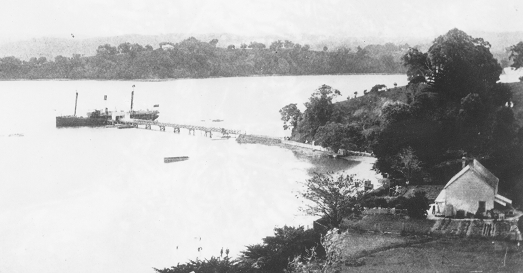
In the beginning
Researcher Montanjees records that:
‘The Mahurangi Heads were surveyed in April 1840 by Felton Mathew as a possible site for the capital of the new colony.’
The land on our peninsula was part of the land bought in 1841, from Māori tribes. The transaction was referred to as ‘The Mahurangi purchase’.
Over the 1852 – 1853 period, the land was more fully surveyed by Charles Heaphy, with (it seems) the assistance of William Denham. In a covering note provided by the Library of New Zealand to the Warkworth Museum, the (copy of the) survey map of Mahurangi Township is said to have been prepared by Denham for the provincial government, who (as Montanjees recorded) were considering the area’s suitability for selection as the site of the colony’s future capital.
H Mabbett states that the survey of Mahurangi Village was completed in 1852. R M Locker, in his book ‘Jade River’, records that there were 204 one acre lots.
Locker notes that the sites were first advertised in 1852, but that there were no takers. He added that in September that year, Thomas Stuart Scott bought 6 one acre lots. However, Mabbett comments that sales of the one acre blocks only commenced in early 1854, and in particular, that he records that Scott bought six [one acre] lots in January 1854. We find Locker’s statements to be historically more logical.
Mabbett states that in late 1853, there were sales of land in rural areas. Mabbett mentions that the Provincial gazette records that Thomas Scott (snr) bought 84 acres of the rural land for 68 pounds 17 shillings.
About this time a number of other individuals became early settlers in our area. They bought land as it became available … for their own use, or on a speculative basis.
Here, you should remember that Coombs and Daldy already were involved in shipping timber spars from the Mahurangi to Auckland. Also, that shipbuilding had commenced around the harbour … the first recorded vessel having been constructed in 1849. History would show that the industry thrived for over 20 years.
Thomas Scott - the early years
Much of what we know about the Scott family comes from Betty Bailey’s monograph: ‘A look back in time’. But writers such as Montanjees, Locker and Mabbett have contributed significantly to our understanding of ‘what went on’ in the days of the early settlers living and working in our area.
So, let’s see what have we learned about Thomas Scott snr and his family.
He was born in 1800, at Blackwall, Middlesex, England. As a young man, Scott went to Nova Scotia. Montanjees’ reports that once Scott was there, he worked in the shipbuilding trade.
From Nova Scotia he moved to Australia, where (in due course) he met his future wife, Ann Louisa Russell (sometimes referred to as Louise). A worksheet we sourced in the Warkworth Museum archives postulated the question as to whether Ann was the brother of Scott’s friend, Thomas Flower Russell (in this vignette, we refer to him as Flower Russell).
Once married, Thomas and Ann had two children. The eldest was named Thomas Stuart Russell Flower Scott, born in Sydney in 1835. He was named after Scott snr’s friend Flower Russell. In our vignette we refer to him as Thomas Scott jnr. The second born son was named George Stuart Scott. The worksheet we mentioned earlier records that George was born in Russell in 1837. This may or may not be correct.
Locker records that on 5 September 1835, on board the ‘Nimrod’, the Scott family sailed from Sydney to Bay of Islands. Also, that the second Scott son was born in 1837. The worksheet we sourced at the Warkworth Museum is the record that records his place of birth as Russell. So we take it she did come to New Zealand, despite some texts reporting that Ann did not come to New Zealand. We believe Locker’s account sets out the most likely scenario.
In support of this, we have seen writings that say that Ann returned to Australia … we are not sure precisely when. Locker identifies that ‘ Mrs Scott’ travelled from the Bay of Islands to Sydney in August 1839, and that a ‘Mr and Mrs Scott’ undertook he reverse voyage later in the year. But, with respect to Ann, there the trail ends.
Reports we’ve read suggest that Ann’ first-hand experiences with the warring Māori had left her troubled about continuing to live in New Zealand. In the unwritten history of the family, there were ‘rumours’ that Ann had died in childbirth, but descendant Mrs M Massey tells us that she has never found evidence that supports this (or for that matter, disproves the suggestion). Whatever the case, we have not seen any mention of Ann ever having made it to Mahurangi.
So, we’ve learned that the Scott family initially were based in the Bay of Islands. Scott snr obviously needed to involve himself in trading ventures, in order to have an income and ‘make his fortune’. Montanjees identified that Scott snr, together with his friend Flower Russell and a certain James Anderson, was involved in land deals with Māori. Montanjees states that the New Zealand Gazette of 15 December 1841 records the trio:
“as one of the claimants to 30000 acres of land near Whangarei, bought from the Māori on 23 May 1839.’
However, it is possible that the family’s arrival in the Bay of Islands was not the first time that Thomas Scott visited our shores. At pages 123-129 of his book ‘Jade River’, Locker provides an interesting account of some aspects of the Scotts early involvement with New Zealand … including involvement with the whaling industry and trading activities.
Locker also tells us that at about the time that the Treaty of Waitangi was being signed, Scott was trading in partnership with Anderson, importing ‘desirable’ wares (such as liquor, tens, saddles, imported foodstuffs, etc) for sale to the public.
But, back to our tale.
It appears that from Whangarei, the Scott trio briefly moved to Auckland, where Scott resumed his trade as a shipwright. In 1852, he moved from Auckland to Mahurangi Heads.
In the meantime, in 1849, the 16 year old Thomas jnr was formally apprenticed to his father, to learn the skills of the shipbuilding trade. You may view the indenture document should you wish. In 1850, a certain James Clare also was indentured to Thomas snr.
Montanjees records that once in the Mahurangi area, Thomas snr bought two blocks of land comprising:
‘30 acres and 10 acres bordering on what is now known as … Scott Point. The land deeds were registered on 7 September 1852, and record the price as being two pound ten shillings an acre.’
Here we remind you of the information Mabbett provided as regard the timing of land sales of different types. The dates noted by the respective writers appear not to correlate. No matter.
Thomas snr built a single storey house on the land he’d bought at Scott Point. In this regard, Scott descendant Bailey notes that on the survey map drawn up by surveyor Charles Heaphy, three buildings are shown on the Scott site. It seems that at least two of these were dwellings of Thomas snr … one of them at least being the first ‘Scott House’ on the peninsula.
In one source document we read a statement that ‘by 1854 the shipbuilding business was flourishing’.
In the Warkworth Museum archives, we found a photocopy of a schematic map which portrayed where shipbuilding had taken place in the Rodney region. Below is an excerpt from that map. We note that the copy had a hand-written notation that indicated it was sourced from H Mabbett’s book entitled ‘The rock and the sky’ (the history of Rodney). Our excerpt provides a useful overview as to where, and by whom, shipbuilding activity occurred in our area.
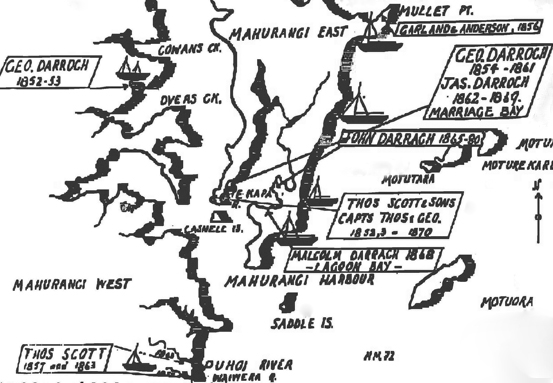
An Appendix to the Montanjees paper ‘Notes on the history of the Scott’s residence‘ sets out a listing of the vessels constructed (by the various Mahurangi shipyards) during the period 1852 to 1880.
From various texts it was apparent that Thomas jnr and George continued to work for their father. Thomas jnr duly completed his seven year apprenticeship, in 1856.
It is clear that over the years, Thomas snr ran a ‘hotel’ (or similar) from premises at Scott’s Bay (as it then was called). For example, in the 7 January 1863 issue of the Daily Southern Cross newspaper, it was reported, in the context of the Mahurangi Regatta that recently had been held, that:

We have presumed that the ‘Mr Scott’ referred to was in fact Thomas Snr, as at this stage, he still was living at Mahurangi Heads. However, that does not of itself mean that Scott held a publican licence. The two often are, but are not necessarily, synonymous.
Many people have believed that Thomas snr held a publican’s licence with respect to premises at Scott Point. Leading historians have concluded otherwise.
However, to muddy the waters a little, Scott descendant Mrs M Massey has drawn our attention to the a record, in the Daily Southern Cross newspaper of 2 September 1863, of the licensing meeting ‘to grant or transfer’ publican licences. It records that ‘Thomas Scott, Mahurangi Heads’ procured a ‘bush licence’.
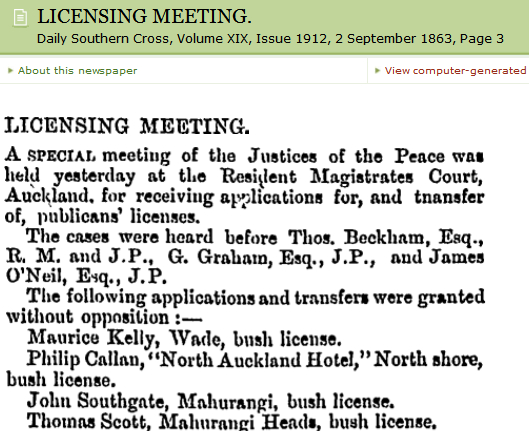
It seems to us strange that in late 1863, Thomas snr should have been making an application to procure such a licence, as it was in that year he had left the Mahurangi area, to live in Auckland. Perhaps the procedural steps to procure the licence were initiated before Thomas snr left the Mahurangi area, and he thought it worthwhile ‘to keep his options open’ with respect to the future use of the premises.
We undertook some homework to see whether Thomas snr had been granted a ‘bush licence’ in previous years, but unearthed no evidence to support that proposition.
So we turned our thoughts to whether the ‘Thomas Scott’ referred to perhaps was ‘Thomas jnr’. The latter (and his wife) are recorded in family annals as being ‘strict temperance people’. However, the New Zealand Herald of 21 April 1869 records an application, by Thomas Scott jnr, for a licence for the ‘Richmond Inn, Mahurangi’. So, things aren’t necessarily ‘as they might have seemed’.
We know that Thomas was a petitioner opposing James Lawrie’s 1881 application for a licence at Mahurangi. We don’t know what Thomas jnr’s motives were in opposing the application, but we suspect that it wasn’t ‘temperance ideals’ that caused him to do so … more likely, commercial or personal self-interest).
So, we don’t have an answer to this conundrum, but, later in this vignette, when we examine the history of Scott House, we’ll revisit the licensing issue.
Bailey confirms that it was in 1863 that Thomas snr moved away from the Mahurangi, to Auckland. By that stage, Thomas jnr and George had taken over their father’s shipyard, trading under the name ‘Scott Bros’. Locker records that the business continued briefly’, but that the last recorded boat from their shipyard was ‘America’, constructed in 1865.
Appendices to ‘Jade River’ contain records of ships built on the Mahurangi, including by the Scott shipyard. Locker records that he personally verified with reference to the Register of New Zealand Ships, 1840-1952.
Thomas snr died in Auckland, on 11 April 1864:

It is recorded that Thomas snr’s parcels of land at ‘Scott’s Bay’ were inherited by Thomas jnr.
The Scott children
On 23 January 1860, George Scott married Susannah Bennett (b.1842). Aside from the fact that they had 9 children (5 boys, followed by 4 girls) … Locker states there were 10 children … we have little information about this marriage, or how George’s life (or his wife’s life) unfolded.
Locker reports that George bought land at Opaheke Bay and built a homestead there … which George’s son James demolished in the 1920s (to make way for a ‘more suitable’ residence for himself and his wife). A historic map we viewed denoted ‘Opaheke Point’ at Mahurangi West, near Jamieson’s Bay, across the water from Casnell Island.
Susannah died in 1915; George died in 1917.
On 2 March 1861, at age 28, Thomas Scott jnr, now a master mariner, married Janet Dorran, roughly 10 years his junior. The Dorran family came to New Zealand in 1842, aboard the ‘Jane Gifford’. This vessel was a 488 ton barque that sailed from Greenock (Scotland) to Auckland … not to be confused with the Whangateau-built scow of the same name. However, Janet was born in Auckland, soon after the family arrived there. It seems to be accepted that the Dorran family moved to Kawau Island, where Janet’s father had engineering / geological involvement with the copper mine there.
In the New Zealand Herald of 9 October 1922, where Janet’s obituary appears, it is stated that at the time of their marriage in 1861, her husband, Thomas jnr, was:
‘… then in charge of the ss Coromandel, and for some years afterwards, in the employ of the Northern Steamship Company.
Locker confirms this with his finding that Thomas jnr went from shipwright to coastal skipper. Even at an early stage of his marriage to Janet, he clearly was not fully occupied by his involvement with the daily activities of the family shipbuilding business … whether by reason of there being an insufficiency of shipbuilding contracts, or of choice or necessity. In a nutshell, the Scott Bros shipyard was foundering.
Over time, Thomas jnr and Janet had 12 children. Sadly, the first three children died in infancy, and two of the others died in their 20s. Of the remaining children, the two eldest, when in their 70s, drowned at sea, while sailing from Mahurangi to Auckland in 1933. You may view an early newspaper report of the incident.
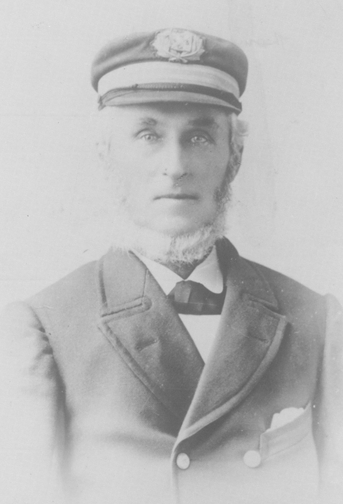
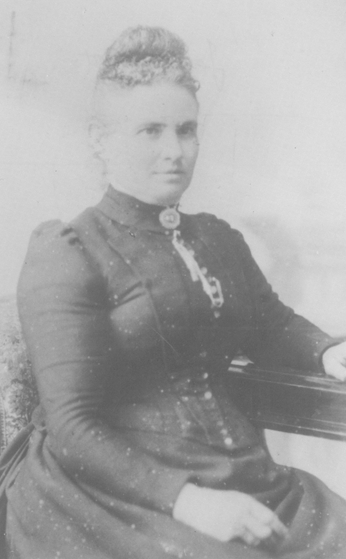
Various records inform us that the house which Thomas snr had built had been a single storey structure. Betty Bailey adds that in the late 1860s Thomas jnr made additions to the family’s dwelling.
This no doubt in part accountable to the increasing size of his and Janet’s family, but perhaps also because of there being insufficient work available to keep him fully occupied.
Historian Harry Bioletti records that the once thriving shipbuilding business on the Te Kapa inlet, and on the Mahurangi Harbour, went into decline in the late 1870s, in part on account of the ‘arrival of steam power and steel hulled ships’. We suspected that ‘the writing had been on the wall’ some years earlier. Locker, in his book ‘Jade River, sets out at pages 146-147, his evaluation of ‘the end of shipbuilding at Mahurangi’. It makes for informative reading.
Montanjees notes that with the decline of the shipbuilding industry, Thomas jnr moved away from the Mahurangi area:
‘He bought a house in Auckland, and he himself returned to the sea as a master mariner.’
The sources differ as to the timing of this move. The research of Bailey and Locker suggest the date was likely to be in the mid-1880s, whereas Montanjees states 1880. Again, no matter.
Montanjees added:
‘During the family’s time in Auckland, the Mahurangi home was leased for a time to a family named Grant. They ran it as a private boarding house … Despite the nickname of ‘Old Hotel’, it was never a licensed hotel.’
Locker states that Thomas jnr’s last command of a sailing vessel was in 1910, and he and Janet then returned to the Mahurangi, where they lived until Thomas’ death in 1911.
Montanjees records that after Thomas’ death:
‘Janet continued to live alone in the house for a number of years. Eventually she was persuaded to move to Auckland . She sold all the furniture leaving only basic essentials, and moved to the city where she spent four months of each year with [each of] her three daughters.’
Janet died in 1922. If you wish, you may read the text of Janet’s obituary that was published in the New Zealand Herald on 9 October 1922.
Both Thomas jnr and Janet are buried in the Scott family plot in the Mahurangi Heads Presbyterian Church cemetery.
In the course of our research, we spotted the following text written by Montanjees in the context of the latter years of the Scott era:
‘When the lease expired, the house was used as a summer house by the Scott family, the older children by now having moved.’
We are not sure to which time period this refers. We suspect it pertains to the period following Janet’s death, but this may not be the case.
Below is a recent photograph of the Scott family plot in the cemetery in the grounds of the old (and long since departed) Mahurangi Heads Presbyterian Church in Ridge Road:
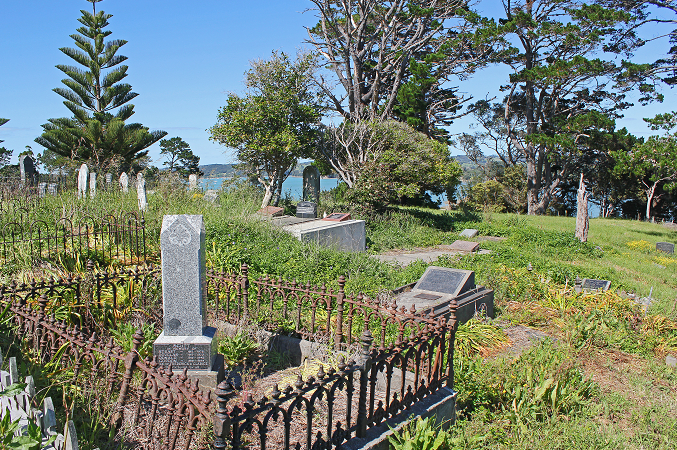
Scott House
We set out below an assortment of information that we gathered in the course of researching the topic of ‘Scott House’. The statements we’ve found do not always correlate, and (at a detailed level) the true historical facts quite possibly will never emerge. Where information doesn’t seem to ‘match’, we leave you to draw your own conclusions.
Betty Bailey notes that on the survey map drawn up by surveyor Charles Heaphy, three buildings are shown on the Scott site. It seems that at least two of these were dwellings of Thomas snr … one of them at least being the first ‘Scott House’ on the peninsula.
The third building on the site might have been the dwelling of Thomas Short (not to be confused with ‘Thomas Scott’). Thomas Short soon thereafter held a publican licence (for the Richmond Tavern, and later for the ‘Mahurangi Hotel’).
In the Daily Southern Cross newspaper of 2 March 1864, the following news entry is recorded:

There apparently is no record of Thomas Scott snr ever holding a publican ‘bush licence’ (well, not prior to 1863 … by which time, Scott had moved to Auckland, where he died in the following year).
The Daily Southern Cross of 16 August 1869, records:
“We learned … that the spacious hotel at Mahurangi Heads, lately occupied by and belonging to Mr Scott, had been destroyed by fire a few days ago. The hotel, we believe, was not tenanted at the time.”
We found this snippet somewhat puzzling. The newspaper’s earlier use of the words ‘lately occupied’ suggests to us that the words ‘not tenanted’ meant ‘available for tenancy’, and not merely ‘not occupied’. We have concluded that the building that burned down is the one which Thomas Short had tenanted, and in relation to which he had held a ‘bush licence’. The newspaper thus is telling us that Mr Scott owned a building which previously had been tenanted by Mr Short. Mr Short had been the holder of a ‘bush licence’. A hotel business had been run from the business. But when the fire occurred, the building was not tenanted. Publican Thomas Short at that stage was a pre-existing tenant, and not at that time running a licenced (or other type of) establishment from that building.
The news entries above also allow us to conclude that Thomas Scott jnr (and his family) were not in any way cocupiers of that particular building. This in turn begs the question as to where Thomas jnr and his family were living at the time. Presumably it was in another building at Scott Point … you may recall that Betty Bailey had identified that even in the 1850s, there had been three buildings separtely identified on survey maps. Certainly, there is no suggestion that Thomas and his family had ‘moved on’ (though Thomas himself was often away from home by reason of being the master of various boats plying the open seas). Here, for the record, we mention that in historical works that we reviewed, Thomas and his family are recorded as having made their move from the Mahurangi (to Auckland) about 1880.
But, all good stories need a twist in the tale. Ponder this: in April 1869, Thomas jnr made an application for a publican licence for the ‘Richmond Tavern’. We haven’t yet found any indication as to whether a licence was granted. The fire occurred in August 1869 … in an unoccupied / untenanted building. Was this event the ‘Cantyre moment’ of its day? It is not for us to resolve the puzzle … but it is an interesting aspect of our yesteryear history.
The Auckland Civic Trust’s documentation refers to the post-fire rebuild occurring in 1877. Bailey herself had talked of Thomas jnr undertaking further building activity in the 1870s. It seems reasonable to infer that the further building work to which Bailey referred involved the construction of the new two-storeyed building nowadays known as Scott House.
This view is supported by the writings of R M Locker, in his book ‘Jade River’. Locker states:
‘While there is a local tradition that the present building was a licensed hotel, the family [descendants] believed otherwise. According to Dulcie Bailey, granddaughter of Thomas Scott jnr: ‘Both Thomas and Janet were very strict temperance people and deeply religious Anglicans’. After research. I conclude that the family was correct. In brief: Thomas Scott certainly ran an inn on this site, which was inherited by Thomas Scott jnr, but run by Thomas Short as publican. After its destruction by fire, Thomas jnr erected a two-storied house in 1877, which apparently was extended in 1881 to become a private hotel or boarding house. It then reverted to the family home. This [replacement two-storeyed] building is the Scott House of today.’
As noted earlier in this vignette, it is clear that Thomas snr was the proprietor of an hotel. A ‘Thomas Scott’ (we are not sure which) procured a ‘bush licence’ in 1863 (after Thomas snr had left the Mahurangi). It is a pity that Locker didn’t record in ‘Jade River’ his views as to the relevance of the 1863 grant of a ‘bush licence’ to ‘Thomas Scott. At this time, we have no firm evidence to suggest that the findings by Locker are in any way incorrect.
Below you’ll find a yesteryear photograph of Scott House, part of its garden, and a portion of Casnell Island. We do not have any indication of the year in which the photograph was captured, but Mrs M Massey (the supplier of the picture) has suggested that the era could be c.1910.
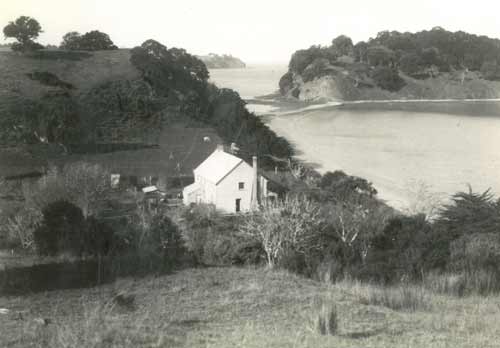
Marie Montanjees supplied us with a yesteryear photograph of Scott House, taken from the opposite direction … and probably taken some years after the preceding photograph:
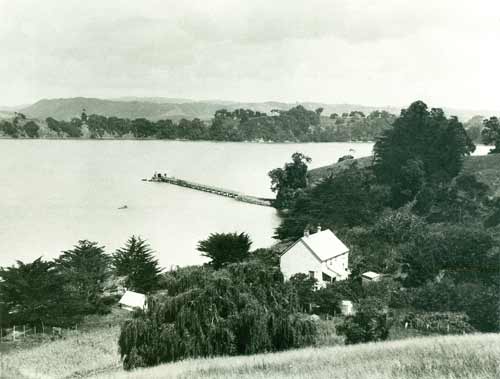
By the late 1980s, the two-storeyed Scott House building had fallen into severe disrepair.
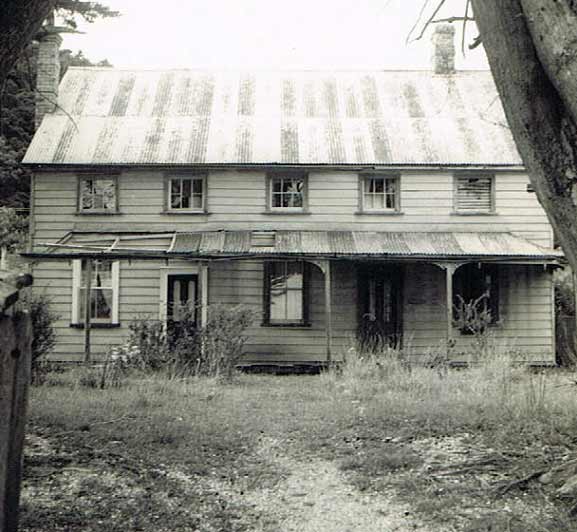
<align=”left”><align=”left”><align=”left”>
This led, in the 1990s, to the Auckland Civic Trust getting involved with funding the restoration of the structure.
In relation to the original 1877 building, the Civic Trust commented that the:
‘… ground floor comprised four rooms with a central hallway and a lean-to scullery, while upstairs there were six bedrooms. Access to the upper floor was either by ladder or external stairway.’
It added that:
‘The present interior stair came as part of the extension a few years later, which added a parlour and an extension to the living room downstairs and two extra bedrooms upstairs.’
Among the papers we found in the Warkworth Museum archives was a photocopy of a floor plan of Scott House, as it was before reconstruction. We suspect the original was part of the documentation that gave rise to the 1990s reconstruction project. If you wish, you may view a copy of that floor plan.
In undertaking research into matters pertaining to Scott House, we observed that there were discrepancies between the written accounts as to the nature and timing of the different physical improvements effected on the Scott property in the 1860s / 1870s, and as to which buildings were so improved.
We find it sufficiently safe to assert that the original building which comprised ‘the hotel’ was in fact (as we have noted) the ‘Scott residence’ which at the time had been vacated by Mr Scott and his family.
Key elements in our thinking are the fact that the Scott Bros shipbuilding venture built its last vessel in 1865, and that Thomas was by now focused on his role as a ship’s captain / master mariner. So it seems distinctly possible that the family had in fact vacated the family home, and leased it out. Perhaps Janet and her children had (for the time being) gone to her parent’s house on Kawau Island?
To conclude our vignette, here are some (undated) further photographs of the two-storeyed Scott House and surrounding area.
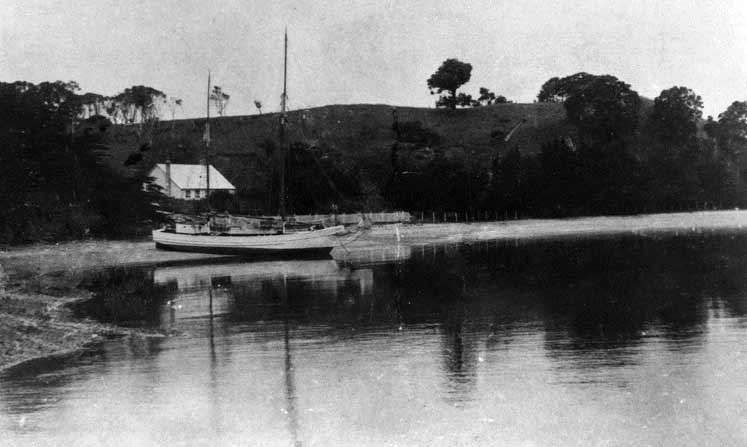
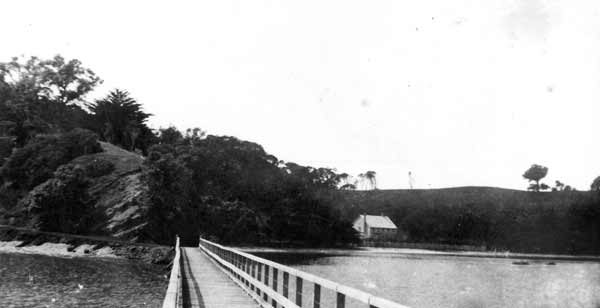
Bibliography
Locker, R M – author of a major historical work, ‘Jade River’. Available at local libraries.
Mabbert, H – a few excerpts from ‘The Rock and the Sky’, found among papers held in the archives at the Warkworth Museum.
Montanjees, Marie – A 1972 research paper focused on ‘The Scott Family’ and aspects of the history of the ‘Scott residence’. This paper is accessible here: Notes on the history of the Scott’s residence
National Library of New Zealand – ‘Papers Past’ facility
Scott, Betty – author of the monograph ‘A look back in time’. Available at local libraries.
Various yesteryear documents, images and charts held in the archives of the Warkworth Museum.
Various yesteryear documents, images and charts made available by Mrs M Massey, Mrs N Lipinski, and other current and former members of (or individuals who had an involvement with) our community.
The following article and video where provided by Auckland Council and are from Claire Cowan, Auckland Council Artisit in Residence
Scott Homestead is one of the oldest buildings in the Mahurangi Harbour and helps us understand the timber, saw milling and boat building industries which flourished there in the nineteenth century. Thomas Scott, a ship builder, purchased the land in 1852, establishing his business there and opening an inn. The inn, known as the Richmond Arms, burnt down in the early 1870s.
Scott Homestead was built in 1877 by his son, also called Thomas. By 1881, the family was running it as an accommodation house, used by summer visitors drawn to the Waiwera hot springs and Mahurangi regatta. The Scott family used the homestead as a holiday house until 1971, when it was purchased by Auckland Regional Authority, who were establishing Mahurangi Regional Park. The homestead was in a dilapidated state and it was at risk of demolition.
Instead, the homestead was leased to the Auckland Civic Trust from 1972-1991, whose volunteers spent many hours restoring the exterior of the house.
As well as the homestead, which is scheduled as historic heritage under the Auckland Unitary Plan, there are also notable trees on site, particularly Macrocarpa.
In 2011 Claire Cowan, Auckland Council Artist in Residence, lived in the homestead.
My family is descended from George Stuart Scott. My grandfather recalls staying in the Scott house as a young man. As a student at North Shore Teachers College in 1982, I was involved with an archaeological excavation in the location at the front of the house, where we found shards of dinnerware and evidence of earlier Maori fire on the site. The house had already begun restoration at this stage, so your photo prior to restoration must be earlier than you had dated. Jo Donovan was a lecturer at the College and was involved with the Civic Trust’s restoration of the site. She is the reason we were involved in the excavation. My family held a joint reunion with the family of Thomas Scott jr at Scott House in the summer of 1989.
Hello,
I am trying to get in touch with any relatives of, and or including H Mabbett the writer of ” The rock and the Sea” for a project regarding the occupation of the Mahurangi area from and including the 1820’s
I found the ship Nimrod listed under Departures in the newspaper “The Colonist” of Sydney.
10th September 1835 Page 7.
Passengers listed as Mr T Scott, James, Margaret and Elizabeth Hawkins, and Louisa Scott.
There is another record I found of a marriage in Sydney 1834. Thomas Scott and Ann L Rupell.
From another source ithe marriage was on 23rd February 1834 at St James Church.
my wife is a descendant of Flower Russell. He had two children in NZ, Alexander and Emma, with a Maori named Waireka. Flower and Alexander came to Australia in the 18850’s. Flower drowned in the Murray river at Mulwala. Alexander married twice and had numerous children. I have a copy of an advertisment placed by Emma Smith in 1871 in the Sydney Morning Herald naming her mother as Waireka and seeking the whereabouts of her father, Flower, and brother Alexander. Emma requested their address be sent to her at Apia on the Navigator Islands ( Samoa ). I would like any information you have on Emma and Waireka. I have not found any thing on them other than two reports of an Emma Russell who lived in Durham St Wellington being in court. aquitted both times. May not be her but the article refers to that street as one where “half castes and Maori live”.
Sydney newspaper “The Colonist” Septemner 10th 1835 records departure of Nimrod for New Zealand. Passengers Mr T Scott, James, Margaret, and Elizabeth Hawkins, and Louisa Scott.
There is record of a wedding in Sydney St James Church 23rd February 1835. Thomas Scott and Ann L Rupell. Spelling could be scanning error??
Ann L Rupell is Russell.
My Grandmother Vera Bell Scott was born in the old house in 1893 to Robert and Charlotte Bell Scott.Our family spent all our summer holidays there. I have a photo of my Grandaughter standing at the gate next to her great,great,great,Grandfather I also have that photo of him on my wall.
According to my mother in law Rachel Nursey b 1885 at Mahurangi River, was brought up by the Scott family and ran the boarding house.Can anyone verify this please?
My wife’s G.G.G. Grandfather was Flower Russell. He was born on 12th April 1813 in Limehouse, East London. He was baptised on 9th May 1813. His parents were Flower Russell (Caulker) and Mary Ann Russell Entry No. 276.
His sister Mary Anne Louisa Russell was born on 21st December 1815, in Limehouse, East London. She was baptised on 3rd January 1816. Her parents were Flower Russell (Caulker) and Mary Ann Russell Entry No. 826. Mary Anne Louisa Russell married Thomas Stewart Scott in Sydney.
Thomas Stewart Scott was born on 4th October 1805. He was baptised on 14th April 1811 Entry No. 1531) in Limehouse, East London. His parents were Thomas Scott (Sawyer) and Elizabeth Scott.
Steve Whatmough (stevewhatmoug@optusnet.com.au)
Hi I’m Kim Johnson ( nee Latham my mother Yvonne Latham Nee O’Keefe)
my Grandmother was Olive Rose Russell.
I’m related to the Alexander Flower Russell who was her Father married to Mary Ann Buchanan family.
I’m interested in your family history book.
Can you help me with Casnell island history please.
Hi my name is Dianne Locker . And I am trying to get hold of a book . If anyone can help me out please do. The book is called The History Of The Locker Family New Zealand. The Publisher was Jenny Hellen.
Jenny Hellen is now the publishing director at Allen & Unwin. T: 09 375 7193 http://www.allenandunwin.co.nz/
Hello I’m just wondering what yearor decade was the original mahurangi scott landing wharf built.
A contract to build a steamer wharf was let for £490 to a William McElroy but I have yet to find a record of the exact date. I did discover he also built the original Waiwera Bridge in 1882. Its possible there was an earlier jetty. There was a regular (weekly) paddle steamer service to Mahurangi Heads (Scott Pt) and Warkworth from 1870 (Lady Bowen) and a more frequent steamer service from the 1880s until 1936 when roads prevailed. A sailing cutter ran before 1870 but may not have needed a jetty. William McElroy died in a tree felling accident in Ruakaka aged only 34. Interestingly his widow and sons later took over Wicklow Hills farm straight across the harbour and lived in the beautiful red roofed homestead still on the point opposite the wharf
For more see historical trail Location 4 (and 6)
https://scottslanding.org/seatsofhistory-location4/
Tender for the steamer wharf at Mahurangi Heads was let to William Mc Elroy July 1880 and works completed March 1881. The wharf was extended and the T enlarged in 1899.
Hello, just trying to find out more about a schooner, “Industry”, which I understand to have been built by Thomas Scott’s company. Mr Locker has her being built in 1858, but there are earlier mentions of a schooner by that name in Papers Past. Any information/suggestions welcome! Ngā mihi, Vivienne